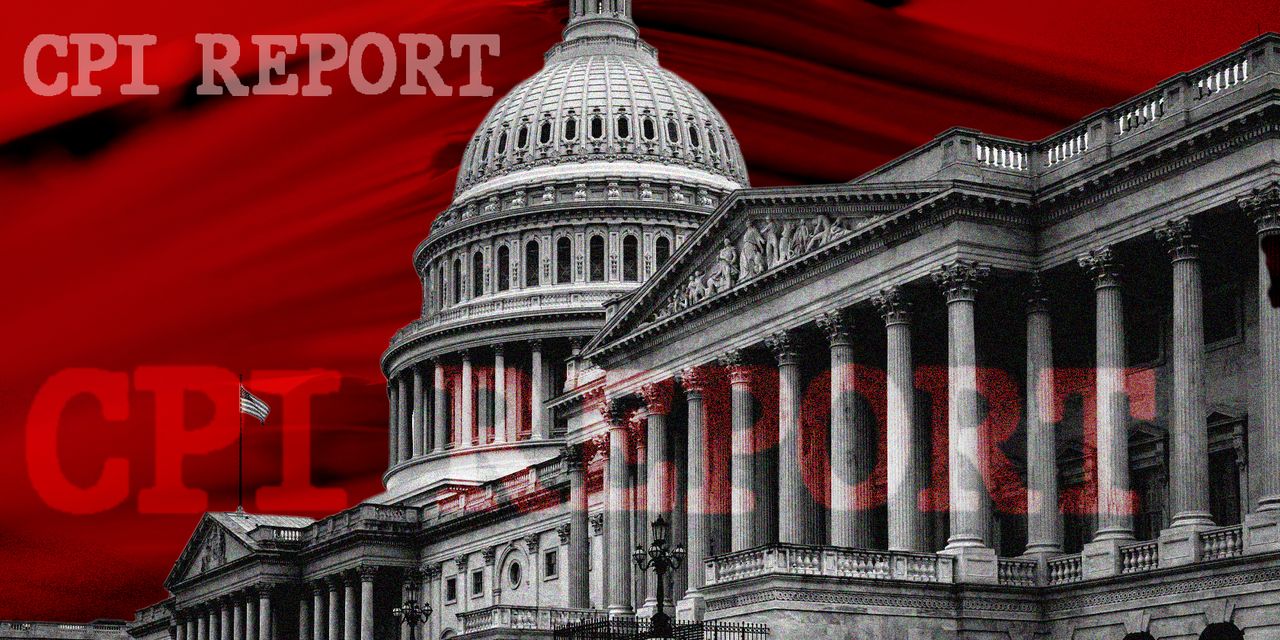The U.S. government is on pace for a partial shutdown in less than two days, leaving the next major U.S. inflation report in a state of limbo with the potential to inject uncertainty into the minds of inflation traders and central bank officials.
The September consumer-price index, set for release on Oct. 12, could go “missing” or be delayed, which might force the government to rely on a replacement index, according to Morgan Stanley strategists Francesco Grechi and Ariana Salvatore, along with economist Ellen Zentner.
Read: McCarthy maintains tough tone as government shutdown on Sunday looks unavoidable
A delay in the release of September’s CPI would come at an inopportune time, given how much the path of U.S. inflation matters to financial markets and Federal Reserve policy makers. Data released on Friday based on the Fed’s preferred PCE measure showed that inflation sped up due to higher gas prices in August, but also decelerated when looking at the narrower core measures that matter most to the central bank.
“During the recent rate hike cycle, the Fed has leaned hard into its preference to rely on incoming data to inform its decisions,” said Carol Schleif, chief investment officer of BMO Family Office in Minneapolis. “This stance would be complicated by a government shutdown, which would stop the delivery of regular economic reports and force the Fed to rely on alternate sources. Ironically, this could prompt them to err toward holding versus hiking,” she wrote in an email to MarketWatch.
The U.S. has been through scenarios like this before, with shutdowns in 1996 and 2013 creating delays in the release of jobs and inflation reports. This time around, any government shutdown that lasts more than two weeks is seen as possibly depriving officials of the data they need to reach a decision on whether to take no action or hike rates further at their next meeting on Oct. 31-Nov. 1.
See also: Shutdown Would Blindfold Fed in Piloting Course on Rates
“‘In the event of a federal government shutdown, the Bureau of Labor Statistics (BLS) will suspend data collection, processing, and dissemination. Once funding is restored, BLS will resume normal operations…’”
If the government does not release the September CPI by Oct. 31, then a replacement index will be announced, based on the most recently reported CPI values for the last available 12 months, according to the team at Morgan Stanley
MS,
In a Friday note titled “A Missing CPI Print,” Grechi, Salvatore, and Zentner said that a shutdown raises the question of how CPI swaps and Treasury inflation-protected securities will be priced. Assuming the September CPI is replaced, real or inflation-adjusted yields will “evolve to be” 2 basis points larger than they otherwise might be, and break-even rates could “artificially” appear to tighten, the team said.
“Inflation investors will thus need to account for the change in the index when interpreting moves in quoted yields,” Grechi wrote.
The U.S. TIPS market is the world’s largest inflation-indexed securities market, with a value of more than $1.77 trillion as of the end of last year. At one point, BlackRock Inc.
BLK,
pegged the market’s size at about 8.5% of the outstanding value of the Treasury market, which would put it closer to $2 trillion currently. The fixings market is smaller than that of TIPS, with trading done over the counter.
While a shutdown that starts just after midnight on Saturday seems inevitable and is a near-consensus view in Washington, how long it might last is still a big question. Based on Kalshi, an exchange where real-world events can be traded upon, the likelihood of a shutdown was seen at 90% earlier on Friday, with an anticipated length of 13 days. In addition, traders saw only a 28% chance that September’s inflation data will be released on time, and a slightly less than one-in-four chance that September’s jobs report will arrive as expected on Oct. 6.
Stacey Standish, a spokeswoman for the Bureau of Labor Statistics, confirmed that in the event of a federal government shutdown, the BLS “will suspend data collection, processing, and dissemination.” Once funding is restored, BLS will resume normal operations, she said.
Meanwhile, traders of derivatives-like instruments known as fixings, who trade directly on the CPI report, are pricing in only a slight chance that a government shutdown will impact their expectations for the September CPI report. They currently foresee an annual headline CPI rate that fails to move meaningfully below 3% until next April — implying a string of seven straight 3% or higher readings from September through March.
“A government shutdown will generate disruptions, for sure, but the fixings market will trade based on whatever the government issues and that should be adequate for now,” said Gang Hu, an inflation trader at New York hedge fund WinShore Capital Partners. “It’s really just a technical bump and the final destination is what really matters.”
Even so, Hu said via phone, the lack of a September CPI report would likely leave the Fed inclined to take no action in November.
Friday’s release of PCE data for August took the wind out of the recent selling seen in Treasurys, with buyers dominating the price action. Treasury yields ended lower on the day, though the 30-year rate
BX:TMUBMUSD30Y
jumped 85.6 basis points during the third quarter for its biggest quarterly gain since March 2009.
U.S. stocks
DJIA
SPX
COMP
finished mostly lower, with the S&P 500 recording its fourth straight weekly loss, as investors weighed comments from New York Fed President John Williams, who said borrowing costs will need to remain high for “some time.”
Read the full article here











Leave a Reply